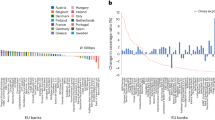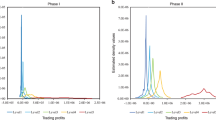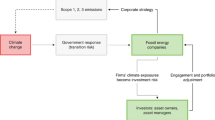Abstract
The participation of financial actors is a key design issue in all emissions allowance markets. Although financials perform several necessary market functions, excessive speculation may undermine market functioning. The potential for harm is gaining prominence as tighter emission limits increasingly attract speculators and investors into allowance markets worldwide. However, adequate warning systems and tools to appraise the beneficial and detrimental facets of financial trading are wanting. We develop preliminary elements of a diagnostic toolbox to assess the scale and impacts of speculation and apply it to the EU emissions trading system. This Perspective seeks to inform current policy debates and invites further research to establish speculation-monitoring systems for allowance markets.
This is a preview of subscription content, access via your institution
Access options
Access Nature and 54 other Nature Portfolio journals
Get Nature+, our best-value online-access subscription
$29.99 / 30 days
cancel any time
Subscribe to this journal
Receive 12 print issues and online access
$209.00 per year
only $17.42 per issue
Buy this article
- Purchase on Springer Link
- Instant access to full article PDF
Prices may be subject to local taxes which are calculated during checkout




Similar content being viewed by others
Data availability
Weekly Commitment of Traders reports used in Figs. 1, 2 and 4a are provided free of charge by trading venues (ICE and EEX) and centrally re-published by ESMA at the following links: ICE, https://www.theice.com/marketdata/reports/234; EEX, https://www.eex.com/en/markets/mifid-ii-mifir; ESMA: https://registers.esma.europa.eu/publication/searchRegister?core=esma_registers_coder58.
Daily trading data (price, traded volume and open interest per futures contract) used in Figs. 1 and 4b and in the Box 1 graphics are proprietary and only available on a paid subscription basis from trading venues (ICE and EEX).
Code availability
This study does not use custom code or mathematical algorithm that is deemed central to its conclusions.
References
Kaldor, N. Speculation and Economic Stability. Rev. Econ. Stud. 7, 1–27 (1939).
Keynes, J. M. Treatise on Money (Macmillan, 1930).
Ekeland, I., Lautier, D. & Villeneuve, B. Hedging pressure and speculation in commodity markets. Econ. Theory 68, 83–123 (2019).
Brunnermeier, M. K., Sockin, M. & Xiong, W. China’s model of managing the financial system. Rev. Econ. Stud. 89, 3115–3153 (2022).
Goldstein, I. & Yang, L. Commodity financialization and information transmission. J. Finance 77, 2613–2667 (2022).
Martin, I. W. R. & Papadimitriou, D. Sentiment and speculation in a market with heterogeneous beliefs. Am. Econ. Rev. 112, 2465–2517 (2022).
Pirrong, C. Market Oversight for Cap-and-Trade: Efficiently Regulating the Carbon Derivatives Market Policy Brief 09–04 (The Brookings Institution, Energy Security Initiative, 2009). An overview of what commodity derivatives are, why they are used, how they are traded, the abuses they are subject to (manipulation, excessive speculation) and how to constrain those abuses with a focus on carbon markets.
Monast, J. Climate change and financial markets: regulating the trade side of cap and trade. Environ. Law Rep. 40, 51–65 (2010).
Fattouh, B., Kilian, L. & Mahadeva, L. The role of speculation in oil markets: what have we learned so far? Energy J. 34, 7–33 (2013).
Cheng, I.-H. & Xiong, W. Financialization of commodity markets. Annu. Rev. Financ. Econ. 6, 419–41 (2014). A literature review on how financial investors affect risk sharing and information discovery in commodity markets, discussing the implications of financialization and ways for improving assessment of these mechanisms.
Kilian, L. & Murphy, D. P. The role of inventories and speculative trading in the global market for crude oil. J. Appl. Econ. 29, 454–78 (2014).
Basak, S. & Pavlova, A. A model of financialization of commodities. J Finance 71, 1511–1556 (2016).
Knittel, C. R. & Pindyck, R. S. The simple economics of commodity price speculation. Am. Econ. J. Macroecon. 8, 85–110 (2016).
Boyd, N. E., Harris, J. H. & Li, B. An update on speculation and financialization in commodity markets. J. Commod. Mark. 10, 91–104 (2018). A literature review on financialization of commodity markets and the various roles of speculation, also using the Working T-index.
Sheppard, D. Hedge funds and Wall St banks cash in on carbon market’s revival. Financial Times (7 September 2018).
Sheppard, D. Carbon trading: the ‘one-way’ bet for hedge funds. Financial Times (23 August 2020).
Buli, N., Abnett, K. & Twidale, S. EU carbon price hits record 50 euros per tonne on route to climate target. Reuters (4 May 2021).
Prices in the world’s biggest carbon market are soaring. The Economist (27 February 2021).
Getting to Net Zero: The Vital Role of Global Carbon Markets (Institute of International Finance, 2021).
Putting Carbon Markets to Work on the Path to Net Zero (McKinsey & Company, 2021).
Jeszke, R. & Lizak, S. Reflections on the mechanisms to protect against formation of price bubble in the EU ETS market. Environ. Protect. Nat. Resour. 32, 8–17 (2021).
Bouleau, N. Limits to growth and stochastics. Real World Econ. Rev. 60, 92–106 (2012).
Berta, N., Gautherat, E. & Gun, O. Transactions in the European carbon market: a bubble of compliance in a whirlpool of speculation. Cambridge J. Econ. 41, 575–593 (2017).
Smith, T. Financialisation of Nature SRE Discussion Paper 08/2021 (Vienna University of Economics and Business, 2021).
Germain, M., van Steenberghe, V. & Magnus, A. Optimal policy with tradable and bankable pollution permits: taking the market microstructure into account. J. Public Econ. Theory 6, 737–757 (2004).
Colla, P., Germain, M. & van Steenberghe, V. Environmental policy and speculation on markets for emission permits. Economica 79, 152–182 (2012).
Borghesi, S. & Flori, A. EU ETS facets in the net: structure and evolution of the EU ETS network. Energy Econ. 75, 602–635 (2018).
Cantillon, E. & Slechten, A. Information aggregation in emissions markets with abatement. Ann. Econ. Stat. 132, 53–79 (2018).
Cludius, J. & Betz, R. The role of banks in EU emissions trading. Energy J. 41, 275–299 (2020). An empirical investigation of the role of banks in the EU ETS, documenting how they act as intermediaries and hedging counterparties for compliance entities.
Friedrich, M., Mauer, E.-M., Pahle, M. & Tietjen, O. From Fundamentals to Financial Assets: The Evolution of Understanding Price Formation in the EU ET (Leibniz Information Centre for Economics, 2020). A synthesis of the empirical literature on price formation in the EU ETS, highlighting three key dimensions (demand-side fundamentals, regulatory intervention, and financial trading) and the need to shed light on how they interact.
Role of Derivatives in Carbon Markets Report (International Swaps and Derivatives Association, 2021).
Carbon Trading in the European Union: An Economic Assessment of Market Functioning in 2021 (Oxera Consulting, 2022).
Angel, J. J. & McCabe, D. M. The ethics of speculation. J. Bus. Ethics 90, 277–286 (2009).
Hart, O. D. & Kreps, D. M. Price destabilizing speculation. J. Polit. Econ. 94, 927–952 (1986).
Newbery, D. M. G. When do futures destabilize spot prices? Int. Econ. Rev. 28, 291–297 (1987).
De Long, J. B., Shleifer, A., Summers, L. H. & Waldmann, R. J. Noise trader risk in financial markets. J. Polit. Econ. 98, 703–738 (1990).
Sockin, M. & Xiong, W. Informational frictions and commodity markets. J. Finance LXX, 2063–2098 (2015).
de Perthuis, C. & Trotignon, R. Governance of CO2 markets: lessons from the EU ETS. Energy Policy 75, 100–106 (2014).
Grosjean, G., Acworth, W., Flachsland, C. & Marschinski, R. After monetary policy, climate policy: is delegation the key to EU ETS reform? Clim. Policy 16, 1–25 (2016).
Koch, N., Grosjean, G., Fuss, S. & Edenhofer, O. Politics matters: regulatory events as catalysts for price formation under cap-and-trade. J. Environ. Econ. Manage. 78, 121–139 (2016).
Salant, S. W. What ails the European Union’s emissions trading system? J. Environ. Econ. Manage. 80, 6–19 (2016).
Final Report: Emission Allowances and Associated Derivatives (European Securities and Markets Authority, 2022). A report on the functioning of the EU ETS and its different market segments (auctions, allowances trading, derivatives trading), providing quantitative analyses and recommendations for improving market data provision and monitoring.
Abrell, J., Cludius, J., Lehmann, S., Schleich, J. & Betz, R. Corporate emissions-trading behaviour during the first decade of the EU ETS. Environ. Resour. Econ. 83, 47–83 (2022). An empirical analysis of the determinants of trading behavior in the EU ETS based on relevant trader characteristics.
Rannou, Y. & Barneto, P. Futures trading with information asymmetry and OTC predominance: another look at the volume/volatility relations in the European carbon markets. Energy Econ. 53, 159–174 (2016).
Emission Trading and Regulation of Financial Markets (German Environment Agency, 2022).
Martin, R., Muûls, M. & Wagner, U. J. The impact of the European Union emissions trading scheme on regulated firms: what is the evidence after ten years? Rev. Environ. Econ. Policy 10, 129–148 (2016).
Zaklan, A. Coase and cap-and-trade: evidence on the independence property from the European carbon market. Am. Econ. J. Econ. Policy (in the press).
Trading Activities and Strategies in the European Carbon Market (German Environment Agency, 2022). A report providing a quantitative analysis of physical allowance trading behavior in the EU ETS with a focus on the energy and financial sectors.
Schopp, A. & Neuhoff, K. The Role of Hedging in Carbon Markets Discussion Paper 1271 (DIW Berlin, 2013).
Quemin, S. & Trotignon, R. Emissions trading with rolling horizons. J. Econ. Dyn. Control 125, 104099 (2021).
Tietjen, O., Lessmann, K. & Pahle, M. Hedging and temporal permit issuances in cap-and-trade programs: the market stability reserve under risk aversion. Resour. Energy Econ. 63, 101214 (2021).
Rannou, Y., Boutabba, M. A. & Barneto, P. Are green bond and carbon markets in Europe complements or substitutes? Insights from the activity of power firms. Energy Econ. 104, 105651 (2021).
Report from the Commission to the European Parliament and the Council on the Functioning of the European Carbon Market in 2020 Pursuant to Articles 10(5) and 21(2) of Directive 2003/87/EC (as amended by Directive 2009/29/EC and Directive (EU) 2018/410) (European Commission, 2021).
2022 State of the EU ETS Report (European Roundtable on Climate Change and Sustainable Transition, 2022).
Hahn, R. W. & Stavins, R. N. The effect of allowance allocations on cap-and-trade system performance. J. Law Econ. 54, S267–S294 (2011).
Martin, R., Muûls, M. & Wagner, U. J. in Emissions Trading as a Policy Instrument: Evaluation and Prospects (eds Gronwald, M. & Hintermann, B.) Ch. 9 (MIT Press, 2015).
Ellerman, A. D., Marcantonini, C. & Zaklan, A. The European Union emissions trading system: ten years and counting. Rev. Environ. Econ. Policy 10, 89–107 (2016).
Proposal for a Directive of the European Parliament and of the Council Amending Directive 2003/87/EC Establishing a System for Greenhouse Gas Emission Allowance Trading Within the Union, Decision (EU) 2015/1814 Concerning the Establishment and Operation of a Market Stability Reserve for the Union Greenhouse Gas Emission Trading Scheme and Regulation (EU) 2015/757 (European Commission, 2021).
Burtraw, D. & McCormack, K. Consignment auctions of free emissions allowances. Energy Policy 107, 337–344 (2017).
MacKenzie, I. A. The evolution of pollution auctions. Rev. Environ. Econ. Policy 16, 1–24 (2022).
Venmans, F. The effect of allocation above emissions and price uncertainty on abatement investments under the EU ETS. J. Clean. Prod. 126, 595–606 (2016).
Baudry, M., Faure, A. & Quemin, S. Emissions trading with transaction costs. J. Environ. Econ. Manage. 108, 102468 (2021).
Cheng, I.-H. & Xiong, W. Why do hedgers trade so much? J. Legal Stud. 43, 183–207 (2014).
Gerlagh, R., Heijmans, R. J. R. K. & Rosendahl, K. E. Endogenous emission caps always produce a green paradox. Econ. Policy 36, 485–522 (2021).
Perino, G. Carbon market design and self-fulfilling prophecies. SSRN https://doi.org/10.2139/ssrn.4243350 (2022).
Kollenberg, S. & Taschini, L. Dynamic supply adjustment and banking under uncertainty in an emissions trading scheme: the market stability reserve. Eur. Econ. Rev. 118, 213–226 (2019).
Perino, G., Willner, M., Quemin, S. & Pahle, M. The European Union emissions trading system market stability reserve: does it stabilize or destabilize the market? Rev. Environ. Econ. Policy 16, 338–345 (2022). A literature review and policy brief on current market design challenges and the Market Stability Reserve in the EU ETS.
Quemin, S. Raising climate ambition in emissions trading systems: the case of the EU ETS and the 2021 review. Resour. Energy Econ. 68, 101300 (2022).
Afonin, A., Bredin, D., Cuthbertson, K., Muckley, C. & Nitzsche, D. Carbon portfolio management. Int. J. Finance Econ. 23, 349–361 (2018).
Pardo, Á. Carbon and inflation. Financ. Res. Lett. 38, 101519 (2021).
Demiralay, S., Gencer, H. G. & Bayraci, S. Carbon credit futures as an emerging asset: hedging, diversification and downside risks. Energy Econ. 113, 106196 (2022).
Jin, J., Han, L., Wu, L. & Zeng, H. The hedging effect of green bonds on carbon market risk. Int. Rev. Financ. Anal. 71, 101509 (2020).
Gerlagh, R. & Heijmans, R. J. R. K. Climate-conscious consumers and the buy, bank, burn program. Nat. Clim. Change 9, 431–433 (2019).
Ye, J. & Xue, M. Influences of sentiment from news articles on EU carbon prices. Energy Econ. 101, 105393 (2021).
On Ancillary Activity – Market Size Calculation – Update for the Year 2020 (European Securities and Markets Authority, 2021).
Boyde, E. Physical carbon credit ETF wins praise despite some misgivings. Financial Times (8 November 2021).
Koch, N., Fuss, S., Grosjean, G. & Edenhofer, O. Causes of the EU ETS price drop: recession, CDM, renewable policies or a bit of everything? − New Evidence. Energy Policy 73, 676–685 (2014).
Friedrich, M., Fries, S., Pahle, M. & Edenhofer, O. Rules vs. discretion in cap-and-trade programs: evidence from the EU emission trading system. SSRN https://doi.org/10.2139/ssrn.3718517 (2020).
Working, H. Speculation on hedging markets. Food Res. Inst. Stud. 1, 185–220 (1960).
Alquist, R. & Gervais, O. The role of financial speculation in driving the price of crude oil. Energy J. 34, 35–54 (2013).
Soares, D. B. & Borocco, E. Rational destabilization in commodity markets. J. Commod. Mark. 25, 100190 (2022).
Garcia, P., Leuthold, R. M. & Zapata, H. Lead-lag relationships between trading volume and price variability: new evidence. J. Futures Mark. 6, 1–10 (1986).
Lucia, J. J. & Pardo, Á. On measuring speculative and hedging activities in futures markets from volume and open interest data. Appl. Econ. 42, 1549–1557 (2010).
Lucia, J. J., Mansanet-Bataller, M. & Pardo, Á. Speculative and hedging activities in the European carbon market. Energy Policy 82, 342–351 (2015). An empirical analysis of hedging and speculation in the EU ETS based on daily trading data (volume, open interest).
Cifarelli, G. & Paesani, P. Navigating the oil bubble: a non-linear heterogeneous-agent dynamic model of futures oil pricing. Energy J. 42, 101–122 (2021).
Wadud, S., Durand, R. B. & Gronwald, M. Connectedness between the crude oil futures and equity markets during the pre- and post-financialisation eras. SSRN https://doi.org/10.2139/ssrn.3892626 (2021).
Chevallier, J., Le Pen, Y. & Sévi, B. Options introduction and volatility in the EU ETS. Resour. Energy Econ. 33, 855–880 (2011).
Stocking, A. Unintended consequences of price controls: an application to allowance markets. J. Environ. Econ. Manage. 63, 120–136 (2012).
Burtraw, D., Holt, C., Palmer, K. & Shobe, W. Price-responsive allowance supply in emissions markets. J. Assoc. Environ. Resour. Econ. 9, 851–884 (2022).
Kim, Y. H. & Yang, J. J. What makes circuit breakers attractive to financial markets? A survey. Financ. Mark. Inst. Instrum. 13, 109–146 (2004).
Yeh, C.-H. & Yang, C.-Y. Examining the effectiveness of price limits in an artificial stock market. J. Econ. Dyn. Control 34, 2089–2108 (2010).
Position Limits for Derivatives (Better Markets, 2011).
Shobe, W., Holt, C. & Huetteman, T. Elements of emission market design: an experimental analysis of California’s market for greenhouse gas allowances. J. Econ. Behav. Organ. 107, 402–420 (2014).
Literature Review on Position Limits (CFTC, 2016).
Chen, T., Gao, Z., He, J., Jiang, W. & Xiong, W. Daily price limits and destructive market behavior. J. Econom. 208, 249–264 (2019).
Sifat, I. M. & Mohamad, A. Circuit breakers as market stability levers: a survey of research, praxis, and challenges. Int. J. Finance Econ. 24, 1130–1169 (2019).
Kachi, A. & Frerk, M. Carbon Market Oversight Primer (International Carbon Action Partnership, 2013).
Stefan, M. & Wellenreuther, C. London vs. Leipzig: price discovery of carbon futures during phase III of the ETS. Econ. Lett. 188, 108990 (2020).
Acknowledgements
For comments and discussions, the authors would like to thank E. Cantillon, B. Doda, M. Kosch, A. Levesque, F. Müsgens, J. Richstein and L. Taschini, as well as participants at the FSR Climate Annual Conference 2020 and EAERE 2022. The authors would also like to thank ESMA and EEX for helpful exchanges and EEX for providing data. This Perspective is neither commissioned by, nor does it reflect the views and opinions of, Électricité de France. All errors and views expressed in this Perspective are solely those of the authors. Funding from the German Federal Ministry of Education and Research under the Kopernikus-Projekt Ariadne (FKZ 03SFK5A) is gratefully acknowledged.
Author information
Authors and Affiliations
Contributions
S.Q. and M.P. conceptualized the project, developed the methodology, performed visualization and wrote the manuscript. S.Q. curated and analysed the data.
Corresponding author
Ethics declarations
Competing interests
The authors declare no competing interests.
Peer review
Peer review information
Nature Climate Change thanks Roweno J.R.K. Heijmans, Simone Maxand and Sam Van den plas for their contribution to the peer review of this work.
Additional information
Publisher’s note Springer Nature remains neutral with regard to jurisdictional claims in published maps and institutional affiliations.
Rights and permissions
Springer Nature or its licensor (e.g. a society or other partner) holds exclusive rights to this article under a publishing agreement with the author(s) or other rightsholder(s); author self-archiving of the accepted manuscript version of this article is solely governed by the terms of such publishing agreement and applicable law.
About this article
Cite this article
Quemin, S., Pahle, M. Financials threaten to undermine the functioning of emissions markets. Nat. Clim. Chang. 13, 22–31 (2023). https://doi.org/10.1038/s41558-022-01560-w
Received:
Accepted:
Published:
Issue Date:
DOI: https://doi.org/10.1038/s41558-022-01560-w



